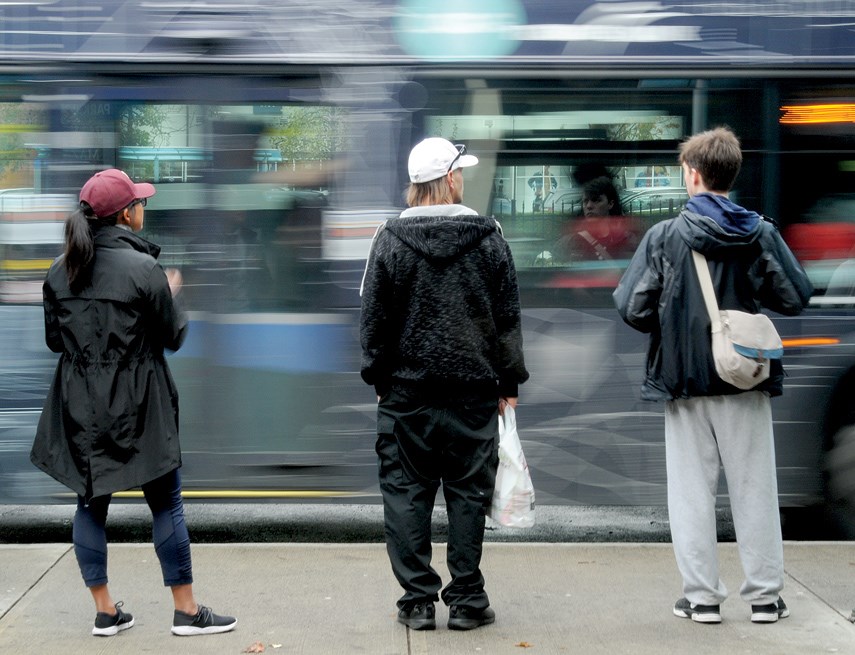The number of people travelling around the North Shore continues to climb but some big shifts are happening in the way we do it.
According to numbers released by TransLink, the percentage of trips made by West Vancouverites behind the wheel dropped from 71.8 per cent from 2011 to 56.4 per cent in 2017, the biggest drop in Metro Vancouver. At the same time, trips on transit grew from 6.5 per cent overall to 14.6 per cent, again one of the biggest shifts in Metro.
Much like a census, TransLink conducts a “Trip Diary” survey of Lower Mainlanders’ transportation habits every five or six years. The 2017 data came from a representative sample of 57,000 residents logging all of the trips made by everyone in their household. The reams of data collected created a snapshot of where we go and how we get there, when we travel and why we went.
Across the region, the share of trips made by drivers fell from 58.8 per cent overall to 55.1 per cent, although in raw numbers, the number of trips by all modes continues to grow. Metro’s population grew by about 250,000 people in that time.
West Vancouver’s outlier status likely has more than a few folks scratching their heads, said Geoff Cross, TransLink’s vice-president of transportation planning and policy, but they’ve only just started to look at the numbers, he said.
“We haven’t done a ton of analysis yet,” Cross said. “Now there are literally millions of pieces of data that we can go through and figure out different questions.”
North Vancouver-Lonsdale MLA and chairwoman of the Integrated North Shore Transportation Planning Project Bowinn Ma said she too was struck by West Van’s apparent growing appetite for transit. “It is surprising and it does raise questions,” she said.
Ma added it shows the arguments against extended rapid bus service into West Vancouver, which council voted against earlier this year, have not aged well.
In the District of North Vancouver, the share of trips by single-occupancy drivers fell from 65.5 to 62.5 per cent. Transit usage also experienced a decline from nine per cent overall to 7.2 per cent, although the number of trips made on foot grew from 7.8 per cent to 11.2 per cent. And, although the numbers are small, the number of trips made by bicycle doubled from 0.7 per cent to 1.5 per cent. North Vancouver District residents also had the highest number of trips per day at 3.75 on average, compared to just over three in Richmond.
City of North Vancouver residents are still the least likely to drive single-occupancy autos on the North Shore, with 55.5 per cent of trips made by a driver alone in 2017 compared to 57 per cent in 2011. Transit and walking both made 2.1 per cent increases over the survey period to 13.2 and 16.2 per cent, respectively. Pedal powered trips fell from 1.3 per cent to 0.9.
Ma said she was also struck by the percentage of trips being made by parents driving their kids to school between 8 and 9 a.m. – even if the school is just a few blocks away.
“According to the trip diary, 25 per cent of all the trips made on the North Shore are to grade schools, and 60 per cent of those are being done by car. That’s really significant,” she said.
In raw numbers, the total number of trips made by single-occupancy vehicles in the North Shore’s three municipalities grew on average from 358,000 to 386,000 per day over the six years, or 7.2 per cent growth.
But Ma said even more dire statistics are emerging through continued research by INSTPP. When the first report was released in 2018, it found North Shore had added about 2,900 jobs between 2011 and 2016 but only 900 working age people, indicating an increasing reliance on commuters. But, more recent data indicate the problem is about three times worse, with 9,200 more jobs here and only 2,700 working age people.
“That’s 6,500 working age people that have jobs here but aren’t living here and, based on the trip diary information, we can guess maybe 60 per cent of those are coming to the North Shore via car,” she said.
Stretched out in a line, that would be about 20 kilometres of additional traffic, Ma added.
“It’s really substantial. This really emphasizes for us that no matter what we do with transportation, we cannot resolve this if we also do not actively work to improve land use and reduce the need for commuting. … We’re talking about housing affordability.”
Meanwhile, the province has named the firm hired to study the feasibility of building a fixed-link rapid transit line from the Lonsdale corridor to downtown Vancouver, which was one of the INSTPP recommendations.
Mott MacDonald Ltd. beat out six other bidders to study the physical geography, current use and future predicted changes as well as projected population increases to come up with possible routes the high-capacity link across might take, as well as costs.
There is a lot of work to be done, Ma said, but it is a critical step towards rapid transit being added to TransLink’s priority list.
“If the North Shore wants rapid transit, we’re going to have to pull together and make a strong case for it,” she said.
“This is an extremely exciting study to be happening right now.”



